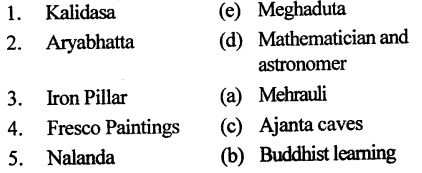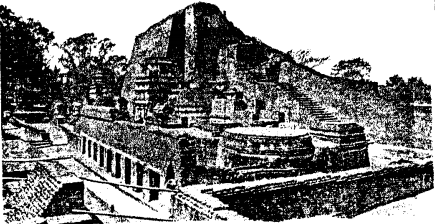The Trail History and Civics for Class 6 ICSE Solutions – The Gupta Empire
ICSE SolutionsSelina ICSE SolutionsML Aggarwal Solutions
The Trail History and Civics for Class 6 ICSE Answers
Trail HistoryCivicsHistory & Civics Geography Biology Chemistry Physics Maths
Keywords
- Navaratnas: means nine gems. This term was used to refer to talented writers, musicians, dramatist, etc. who were present in the king’s count.
- Huns: They were barbarians who invaded India.
- Kumaramatyas: They were officials who assisted the princes in governing the provinces.
- Vishyapatis: They were the officers who looked after the administration of the districts or vishyas.
- Vaishnavas: They are the worshippers of Lord Vishnu.
- Bhakti cult: It was a religious cult that believed that God could be reached through intense and true devotion and not through rituals.
- Aryabhatta: He was a famous mathematician and : astronomer who discovered that the earth moves around the sun, and the reasons for lunar and solar eclipses.
- Vagbhatta: He wrote a book on ayurvedic medicine.
- Kalidasa: He was the most famous Sanskrit poet and dramatist of this period.
EXERCISES
A. Fill in the blanks:
- The Allahabad Pillar inscription by the court poet Harisena is a valuable source of information for the Gupta period.
- The Pallava ruler of Kanchi formed a confederacy of the rulers of southern India.
- The rulers of southern India accepted Samudragupta as their overlord and paid tribute to him.
- Samudragupta celebrated his conquests by performing the Ashvamedha yagna.
- Samudragupta was not only a military genius but a talented musician and poet as well.
- Chandragupta Vikramaitya strengthened his position by matrimonial alliances.
- The account of the Chinese traveller Fa Hien is a valuable source of information for the Gupta period.
- The Gupta period is generally known as the Golden Age of ancient India history.
B. Match the following:

![]()
Answer:

C. Choose the correct answer:
1. The foundation of the Gupta empire was laid by Samudragupta/Chandragupta I/Kumaragupta.
Ans. The foundation of the Gupta empire was laid by Chandragupta I.
2. Samudragupta defeated 12 kings in norther/western/ southern
Ans. Samudragupta defeated 12 kings in southern India.
3.Vagbhata/Aryabhata/Varahamihira wrote a book on the ayurvedic system of medicine.
Ans. Vagbhata wrote a book on the ayurvedic system of medicine.
4. Kalidasa / Vagbhata / Aryabhata was one of Vikramaditya’s nine germs.
Ans. Kalidasa was one of Vikramaditya’s nine germs.
5. The last important ruler of the Gupta dynasty was Skandagupta/Kumaragupta/Samudragupta.
Ans. The last important ruler of the Gupta dynasty was Skandagupta.
D. State whether the following are true or false:
- Criminals were punished severely during the reign of the Guptas.
False.
Correct: Criminals were usually fined during the reign of the Guptas. - There was an elaborate spy system under the Guptas.
False.
Correct: There was no elaborate spy system under the Guptas. - Taxes were light during the Gupta period.
True. - The Gupta encouraged the revival of Hinduism.
True. - The Guptas followed a policy of religious tolerance.
True.
E. Answer the following questions in one or two words/ sentences:
Question 1.
Why did the Pallava ruler of Kanchi form a confederacy against Samudragupta?
Answer:
The Pallava ruler of Kanchi form a confederacy against Samudragupta because he realized that he could not face Samudragupta alone. So he formed a confederacy of the kings of South India under his leadership.
Question 2.
Why did Samudragupta not annex the South Indian kingdoms after defeating them?
Answer:
Samudragupta did not annex the South Indian kingdoms because he realized it would not be easy to control such a vast empire without proper transport and communication facilities.
Question 3.
Why did the frontier states of the east and the west surrender to Samudragupta?
Answer:
The frontier states of east and the west surrender to Samundragupta because the ruler of these states accepted him as their overlord and paid large sum of money as a tribute.
Question 4.
Why did Samudragupta perform the Ashvamedha yagna?
Answer:
Samudragupta celebrated his conquests by performing the Ashvamedha yagna.
Question 5.
What was the extent of Samudragupta’s empire?
Answer:
Samudragupta’s empire extended from Bengal in the east to Delhi in the west from the Himalayas in the North to Narmda in the South. His indirect control over the vassal states also.
Question 6.
Name the Chinese scholar who visited India during the reign of Chandragupta Vikramaditya.
Answer:
Fa Hien visited India during the reign of Chandragupta Vikramaditya.
Question 7.
Mention two important reasons for the downfall of the Gupta empire.
Answer:
The important two reasons for the downfall of the Gupta empire are following.
- Skandagupta’ successors were week.
- They could not protect the empire from the repeated onslaughts of the Huns.
Question 8.
Why did the religious beliefs of the Bhakti cult gain mass popularity?
Answer:
Bhakti cult which believed in selfless devotion to God gained mass popularity as this cult was inexpensive and simple.
Question 9.
Name the most outstanding Sanskrit playwright of the Gupta period.
Answer:
Kalidasa was the most famous Sanskrit poet and playwright of this period.
Question 10.
Which Buddhist university was patronized by the Gupta rulers?
Answer:
The Buddhist university of Nalanda was patronized by the Gupta rulers.
F. Answer the following questions briefly:
Question 1.
What was the political condition of India after the decline of the Kushans and the Satavahans?
Answer:
After the decline of the Kushans and Satvahanas. India was divided into a number of small kingdoms and republics. This period of political chaos and instability.
Question 2.
How did Chandragupta Vikramaditya strengthen his power and position through
- Matrimonial alliances and
- War?
Answer:
Matrimonial alliances:
Chandragupta Vikramaditya strengthen his position by matrimonial alliance. He married the daughter of a powerful Naga ruler. He gave his daughter in marriage to the Vakataka ruler in the Deccan from whom he got valuable help during his campaigns against the Sakas.
War:
Chandragupta extended the western boundaries of his empire to Arabian Sea by defeating the Saka ruler. This was a very important victory because it gave the Guptas control over the three great seaports on the western coast. These were outlets to vast overseas trade. This led to economic growth and prosperity. He moved his capital to Ujjain.
Question 3.
What according to Fa Hien was the condition of the people during the Gupta period?
Answer:
According to Fa Hien’s account the people were honest, secure, prosperous and happy during Gupta Period. There was no capital punishment, for very serious crimes like treason and rebellion the right hand was cut off. Criminals were usually fined. Taxes were light.
Question 4.
Rapid progress was made during the Gupta period in the fields of
(1)Astronomy and
(2) Mathematics. Explain.
Answer:
- Astronomy:
A tremendous progress was made in the field of astronomy. Aryabhatta who was a known astronomer discovered the movements of earth i.e., it moves around the sun on it axis. He also found out the causes of lunar and solar eclipses. - Mathematics:
The discovery of the zero and decimal system was made in use during Gupta period.
Question 5.
How do we know that
(1) The science of metallurgy was highly advanced and
(2) Education was encouraged during the Gupta period?
Answer:
- Metallurgy:
Mehrauli pillars throw light on the iron metallurgy of this period. The pillar was built in the 4th century ce has not rusted in the last few centuries. The 25 meter high copper statue of Buddha and the numerous gold coins testify the skill in metal casting. - Education: The Guptas encouraged education and learning. Liberal grants were given to educational institutions. Their greatest contribution was the establishment of the Nalanda University, which became very famous during the reign of Harsha in the 7th century CE.
The Nalanda Universtiy was a center of Buddhist learning. Medicine, astronomy, grammar, philosophy and Vedic literature were some of the other subjects taught at this university.
G Picture study.
This is a picture of the ruins of an ancient university.

1. Identify the university.
Ans. This is a picture of Nalanda University.
2. Mention the subjects taught in this university.
Ans. Medicine, astronomy grammar philosophy, and Vedic literature were taught in Nalanda University.
3. Which dynasty established this university?
Ans. Gupta dynasty established this University.
4. What contributions did this dynasty make in the fields of
(1) astronomy (2) metallurgy (3) literature ?
Ans.
(1) refer Ans. F. (4) (1)
(2) refer Ans. F. (5) (1)
(3) Literature: During this period Kalidasa wrote famous play Shakuntala and the epic poem Meghaduta. The Panchatantra was compiled, the Puranas were rewritten, and the Mahabharata was revised and rewritten during this period. Shudraka’s Mrichchhakadka was also written during this time.
OTHER IMPORTANT QUESTIONS
Question 1.
Which title was given to Chandragupta I?
Answer:
Chandragupta I was given the a title of Maharajadhiraja.
Question 2.
Who was the founder of the Gupta Empire? When he found this empire?
Answer:
Chandragupta I was the founder of the Gupta Empire. He founded his dynasty in 320 AD and ruled tile 335 AD.
Question 3.
What is the main source of knowledge about Samudragupta and his conquests?
Answer:
An inscription, engraved on a pillar at Allahabad is the main source of information about Samudragupta’s conquest.
Question 4.
Who was Fa-Hien? What does he tells us about the people of India?
Answer:
Fa-Hien was a Chinese scholar. He came to India from China during the reign of Chandragupta II.
He tells us that people of India were honest, secure, prosperous and happy. Criminals were not punished but fined. Taxes were light. There was no spy system.
Question 5.
Who were the Huns? How did they affect Gupta kingdom?
Answer:
They were nomads. They attacked Northern India in the fifth century.
Huns has destroyed the Gupta empire and shattered political unity of India.
Question 6.
Why is the Gupta period called ‘Golden Age’ of Ancient India?
Answer:
The Gupta period is called ‘Golden Age’ of the ancient India because a tremendous progress in all fields like science, astrology, mathematics, art and sculpture and literature was made which made people happy and prosperous. Moreover the moral based society carried religious tolerance and respect for other religions. The government did’n interfere in the daily life and work of the people.
Question 7.
What progress did the Guptas make in the Medicine?
Answer:
Vegabhatta and Dhanvantri were famous physicians and surgeons who served the people during this period.